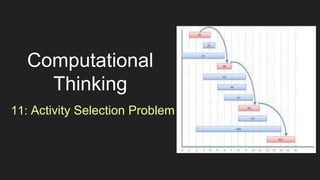
Computational Thinking 11- ActivitySelection.pptx
- 2. Outline 1. Introduction 2. Real Life Applications of ASP 3. Model Formulation 4. Problem Solving 5. Example 6. Summary
- 3. 1. Introduction ● An activity selection is the problem of scheduling among several competing activities ● We have a list of activities with their starting time and finishing time. ● Our goal is to select maximum number of non-conflicting activities that can be performed by a person or a machine, assuming that the person or machine involved can work on a single activity at a time. ● Any two activities are said to be non-conflicting if starting time of one activity is greater than or equal to the finishing time of the other activity.
- 4. ● In order to solve this problem we first sort the activities as per their finishing time in ascending order. ● Then we select non- conflicting activities.
- 5. Interval Scheduling Problem ● The activity selection problem is also known as the Interval scheduling maximization problem (ISMP), which is a special type of the more general Interval Scheduling problem. ● ISMP is about Job Sequencing Problem with Deadline. This problem consists of n jobs each associated with a deadline and profit and our objective is to earn maximum profit. We will earn profit only when job is completed on or before deadline. We assume that each job will take unit time to complete.
- 6. 2. Real Life Applications of ASP Following are some of the real-life applications of this problem: ● Scheduling multiple competing events in a room, such that each event has its own start and end time. ● Scheduling manufacturing of multiple products on the same machine, such that each product has its own production timelines. ● Activity Selection is one of the most well-known generic problems used in Operations Research for dealing with real-life business problems.
- 7. 3. Model Formulation Assume we have n activities with their start and finish times, the objective is to find solution set having maximum number of non- conflicting activities that can be executed in a single time frame, assuming that only one person or machine is available for execution. Some points to note here: •It might not be possible to complete all the activities, since their timings can collapse. •Two activities, say i and j, are said to be non-conflicting if si >= fj or sj >= fi where si and sj denote the starting time of activities i and j respectively, and fi and fj refer to the finishing time of the activities i and j respectively.
- 8. Input and Output Specifications Input Data for the Algorithm: •act[] array containing all the activities. •s[] array containing the starting time of all the activities. •f[] array containing the finishing time of all the activities. Ouput Data from the Algorithm: •sol[] array refering to the solution set containing the maximum number of non-conflicting activities.
- 12. Algorithm Following are the steps we will be following to solve the activity selection problem, Step 1: Sort the given activities in ascending order according to their finishing time. Step 2: Select the first activity from sorted array act[] and add it to sol[] array. Step 3: Repeat steps 4 and 5 for the remaining activities in act[]. Step 4: If the start time of the currently selected activity is greater than or equal to the finish time of previously selected activity, then add it to the sol[] array. Step 5: Select the next activity in act[] array. Step 6: Print the sol[] array.
- 14. Let's try to trace the steps of above algorithm using an example: In the table below, we have 6 activities with corresponding start and end time, the objective is to compute an execution schedule having maximum number of non-conflicting activities: Example 2
- 15. A possible solution would be: Step 1: Sort the given activities in ascending order according to their finishing time. The table after we have sorted it:For the data given in the above table, A.Select activity a3. Since the start time of a3 is greater than the finish time of a2 (i.e. s(a3) > f(a2)), we add a3 to the solution set. Thus sol = {a2, a3}. B.Select a4. Since s(a4) < f(a3), it is not added to the solution set. C.Select a5. Since s(a5) > f(a3), a5 gets added to solution set. Thus sol = {a2, a3, a5} D.Select a1. Since s(a1) < f(a5), a1 is not added to the solution set. E.Select a6. a6 is added to the solution set since s(a6) > f(a5). Thus sol = {a2, a3, a5, a6}. Step 6: At last, print the array sol[]
- 16. Optimal Solution
- 17. Example 3
- 19. References 1. https://dyclassroom.com/greedy-algorithm/activity-selection-problem 2. https://dyclassroom.com/greedy-algorithm/job-sequencing-problem-with-deadline 3. https://www.studytonight.com/data-structures/activity-selection-problem# 4. https://www.slideserve.com/graiden-sykes/in-the-name-of-god-algorithms-design- greedy-algorithms 5. https://slideplayer.com/slide/17736397/
- 20. Thank You